The rare “Eureka!” moment when troubleshooting finally pays off

I just finished a three-part series about shimmed valve adjustment in my 1974 Lotus Europa Twin-Cam Special. You wouldn’t think I could get a fourth article out of it. And you would be wrong. After all that work, it didn’t start. So today we’re going to troubleshoot.
The very word “troubleshoot” implies that you don’t know what the cause is—that is, it’s not like a leaking hose that you can clearly see needs to be replaced, or hearing your brakes let out a metal-on-metal squeal and knowing that you need to buy pads and rotors. And the funny thing is that the more vexing the problem is, the less likely it seems that you have a true “Eureka!” moment at the end. I’ve thought long and hard about this, and I think that the reason why is because, instead of being blown away and wonderous at the mechanical and electrical processes that caused the problem and your deductive skills that fixed it, your reaction is instead “THAT? THAT was the cause? I should’ve thought about that weeks ago.”
First, a quick story. About eight years ago I was sorting out a 1972 BMW 2002tii that I’d recently bought. The distributor wasn’t advancing, so I had it rebuilt by a reputable shop, then fit it with new points, condenser, rotor, cap, plug wires, and coil. I drove the car a few miles when it began stumbling so badly that I barely made it home. It made no sense. My friend Lindsey Browne, a professional mechanic, offered to, as he sometimes says, “come over and play.” When he arrived, he was holding a distributor, plug wires, and coil. “I just pulled these from my 2002,” he said, “so they’re known good. Let’s swap the distributor into your car and see what it does.”
I protested. “How can you say that yours are ‘known good’ and mine aren’t? My distributor was just rebuilt by the best person in the business. And the distributor parts—cap, rotor, points, and condenser—came straight from the dealer in BMW boxes. I have zero question that they’re good.”
Lindsey looked at me, paused, smiled slightly, and mock-admonished me, “ARE YOU HAVING A PROBLEM OR AREN’T YOU?”
“Well… yes,” I said sheepishly, while muttering under my breath, “Grumble gripe known good my butt mumble mumble.”
We put Lindsey’s distributor in my car, and it fired right up. My jaw hung open.
“Now,” he said, without a hint of gloating, “we’ll swap one component at a time from your distributor into mine and see where it fails.”
It was the condenser. A brand-new Bosch condenser, purchased from a BMW dealer, in a BMW-logo box, had failed in a few miles.
It was a lesson I try never to forget. There really is no “known good.” There are only symptoms and diagnosis. And whenever you say, “Well, it can’t be that,” you need to admit that you have a big blind spot behind centered on that.
There are a few other dynamics that people try to bring into troubleshooting. One is the idea that if something was working, and now it’s not, it’s the last thing you did that broke it. The other is the Sherlock Holmes-ian idea that if you remove the impossible, whatever remains, however improbable, is the answer. I’ve never been overly enamored of either of these, since A) sometimes things simply break, and B) sometimes the thought process that leads you to “impossible” is faulty.
And with that, let’s talk about the Lotus. After spending three weeks carefully completing the shimmed valve adjustment, the car wouldn’t start. It would crank over fine, but there wasn’t even the burble of the ignition attempting to catch. Then, while cranking, I heard an abrupt THUNK and the cranking stopped. That raised the specter that I’d screwed something up in the valve timing and that the pistons were hitting the valves. I immediately pulled the valve cover off, rotated the engine manually to Top Dead Center (TDC), re-checked the cam alignment marks, and spun the engine a few times by hand without feeling any obstruction. Relieved but puzzled, I returned to troubleshooting, only to have the THUNK return. It seemed likely that the starter motor (original to the car) was failing and the THUNK was coincidental to the no-start, but it was certainly jarring.
Now, it’s often said that an engine needs two things—gas and spark—to start. That’s true, but incomplete. To start, an engine needs:
- To turn freely
- Compression
- A sufficiently strong spark that’s at least approximately correctly timed to TDC on the cylinder’s compression strokes
- Fuel mixed with air that’s in the ballpark of the right ratio (neither insanely lean nor insanely rich)
- Fuel and air to be drawn into the cylinders
With the car cranking but not starting, the first thing I did was check for spark. I did this in three ways. First, I connected a dwell meter to the coil. It read about 68 degrees, slightly above the 60-degree spec but certainly close enough. Next, I pulled the center wire out of the distributor cap, held it near ground, and cranked the engine with a remote start switch. It sparked rapidly. Lastly, to make sure spark was actually reaching the plugs, I pulled a plug wire, stuck a screwdriver into it, and held the shank near ground, and I saw it spark about a quarter as quickly, as expected. So, spark, that’s a big check.
Next was fuel. The float bowls in the Lotus’ Strombergs have plugs at the bottom. I began to pull one plug, and my hand became wet with gas. Of course, it’s possible that sediment or gum are clogging up the jets and fuel isn’t making it into the intake manifold, so I took off the air cleaner, held the throttle plates open, and gave it a good blast of starting fluid while I was cranking. There still wasn’t even a burble of ignition. This seemed to indicate that the engine wasn’t getting spark, even though my eyes told me it was.
Now, this could be due to a few things. It could be that spark was present but wasn’t strong enough to start the engine. It could be that the plugs were fouled, even though they looked fine. Or it could be that the timing was so far off that the plugs weren’t firing when the pistons were anywhere near the top of their compression strokes. The latter idea made symptomatic sense, but the distributor hadn’t been removed, or even moved at all, so I discounted it. Besides, the distributor on this engine is located under the intake manifold and is a bit of a pain to service once the engine is installed.
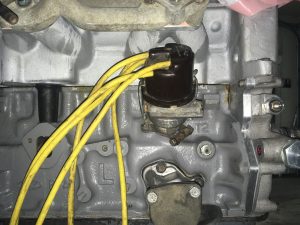
I posted all this to my Facebook page (with most of us self-quarantining at home, many folks regard me as welcome entertainment), and the advice poured in. Many of the comments centered on the “last thing you did” idea. This did make sense, since, after all, the shimmed valve adjustment I’d just completed was pretty invasive, with the timing chain disconnected and the cams and their gears removed. When I mentioned this, many folks jumped to the idea that, since the cams spin twice as fast as the crank, I must have indexed the cams incorrectly, or had the cams swapped, or their gears swapped, or something. I triple-checked and verified that, indeed, when the mark on the flywheel for #1 TDC was lined up with the pointer, the cam alignment marks were correct.
To be certain, I stuck a wooden dowel down the plug holes, verified that pistons #1 and #4 were at the top, #2 and #3 were at the bottom, and checked that the valves for #1 were both closed, indicating it was at the top of its compression stroke, and that the #4 valves were “overlapped” (the exhaust valve closing and the intake valve opening), indicating that it was at TDC for its exhaust stroke. Everything matched the manual as well as the photos I took before I dismantled the valve train. I was absolutely sure the valve timing was correct and not off by 180 degrees.
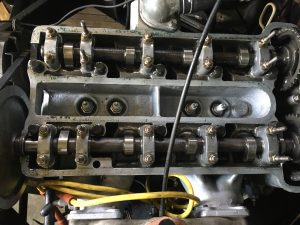
There were similar comments that I must somehow have the ignition 180 degrees out, timed for #4 instead of #1. Even though I couldn’t see why the timing would’ve changed, I rotated the engine to TDC and popped the cap off the distributor, then remembered that, unlike the BMWs I’m used to, there isn’t a mark on the distributor for #1. You need to infer where it is from the location of the contact for #1 plug wire, and that’s challenging because all the plug wires emerge from the side of the cap because of the scant clearance from the intake manifold above it. As near as I could tell, the rotor was pointing in the general vicinity of the notch in the cap, which was close to the contact for #1 plug wire. It certainly wasn’t 180 degrees out.
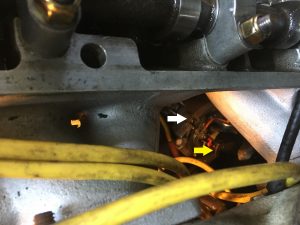
The other related thing it could’ve been was mis-numbered or mis-attached plug wires. They had, after all, been disconnected. When I’d installed the distributor after rebuilding the engine, I’d marked the spark plug ends of the plug wires with their cylinder numbers. I looked up the firing order (1-3-4-2) and the direction of rotation of the rotor (counterclockwise), traced each plug wire, and verified that I had it correct.
I began looking at some of the lower-probability causes. Compression? I did a test, and all cylinders were about 180 psi. Someone suggested the idea that perhaps the fuel/air wasn’t being drawn into the cylinders due to some blockage in the intake manifold, or a massive vacuum leak, or the intake valves not opening because the cam wasn’t seated properly. One cylinder at a time, I rotated the engine so the cam lobe was opening its intake valve, then blew compressed air into the cylinder. I could clearly hear it escaping out the air cleaner housing. I also attached a vacuum gauge to a port on the intake manifold, and it clearly showed the presence of vacuum. Hey, if you’re crowd-sourcing advice, it’s a good idea to take it.
Now, the Europa being a mid-engine car, there was the remote possibility that I’d numbered the plugs backwards. I looked this up online and learned that, in fact, the earlier Renault-based Europas did label plug #1 as the most rear-facing one, as it’s the first plug you see, the one closest to you, when you open up the engine compartment. This apparently was corrected to the more traditional “front is pulley, rear is flywheel, #1 is front” numbering when the Twin-Cam engines came in. Still, I wasn’t absolutely certain that I knew about that when I numbered the plug wires last year, so I could have had them wrong. I reversed them, tried to start the car, and was greeted with a backfire so loud I thought I’d ruptured an eardrum.
Clearly, I did have a timing problem, even though it made absolutely no sense to me that the timing would’ve changed.
I wanted to pull the distributor out to make sure it wasn’t broken in some way, but I knew that when I did I’d lose any information on where the timing was currently set, so I first rechecked where the rotor was. Since the intake manifold was in the way, I couldn’t look straight down on the cap, but I tried to do a better job of seeing where the #1 plug wire contact was. It turned out to be further counterclockwise from the notch than I’d expected. I marked that with Wite-Out, and then looked at the rotor’s position. It was further off than I’d thought, but again, not wildly so, certainly not 180 degrees, or even close to 90.
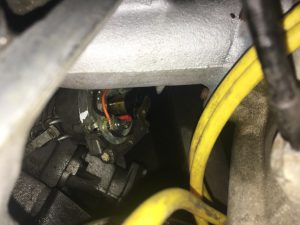
I pulled the distributor completely out of the car and inspected it. It didn’t appear to be damaged in any way and rotated freely. The points looked good, free of obvious mounds or pits. These were the points and condenser (and rotor, cap, and plug wires) that were in the car when it was rolled into storage 41 years ago, but as per the experience with my 2002tii, the quality of new ignition parts is often poor, so I was loathe to change them. Besides, I didn’t want to introduce another variable. I measured the point gap and found it correct. I then fit the cap, and while staring straight down on the distributor, saw that the Wite-Out mark I’d painted wasn’t far enough over, making the rotor position even further off from where it should’ve been at TDC. I repainted the mark at the correct location.
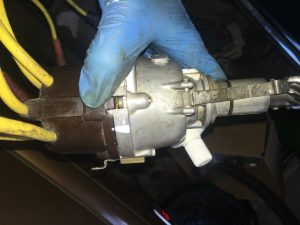
I carefully put the distributor back in, making sure that the rotor pointed at the mark. On any distributor with a helical gear on the end, the rotor will rotate as you push the distributor in, so you need to pre-rotate it so it winds up where you want.
I then needed to statically re-time the engine. The spec for static timing on the Europa varies depending on whether it’s a Euro or Federal-spec car and whether the distributor has a vacuum advance or not. I wanted to get it right, so I quit for the night, came inside, and looked online for the correct spec. For things that are specific to the Twin-Cam engine, I’ll sometimes look on the Elan forum, since all Elans have the “twinc” engine whereas only about a third of the Europas do.
I was stunned when I stumbled onto the following post:
“What I cannot get my head around is the relationship between the jackshaft (the third cam in the twin-cam engine!) and the rest of the valve timing. The position of the jackshaft doesn’t get a mention in any of the stuff I’ve read about timing marks on cam sprockets pointing together at TDC, but how do I know that the distributor, which is driven by the jackshaft, is going to fire at the right point? Does it not matter and I just turn the dizzy right around until it’s at the correct place?”
Eureka!
This engine, whose formal name is the Lotus-Ford Twin-Cam engine, began its life as a conventional Ford 1600 block that originally ran a pushrod head. It still retains its vestigial camshaft, referred to as the “jackshaft,” which runs the oil pump, the fuel pump, and—ta-da—the distributor. Although I had not read, in either the factory manual or the Wilkins Lotus Twin-Cam Engine bible, that you need to reset the timing after you pull the cams and adjust the valves, it made perfect sense. I had supported the timing chain with a pair of coat hangers so it wouldn’t drop down into the case and fold up and jam the crankshaft gear, but it never occurred to me that, if it slipped a tooth or two on the jackshaft gear, it’d spin the distributor and the timing would be off.
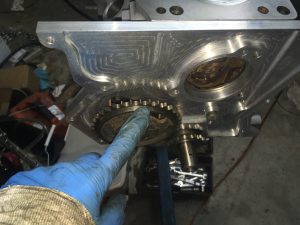
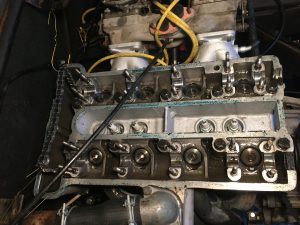
The correct static timing for my car is about 10 degrees before TDC. To set it, you put a test light or a voltmeter between the negative side of the ignition coil and ground, and either rotate the engine or rotate the distributor so that the rotor contacts #1 plug wire terminal and lights the light when the engine is at 10 degrees BTDC. It’s easiest if you set the engine to 10 degrees BTDC, then rotate the distributor until the light goes on, but the trick is that you need to rotate the distributor to simulate the rotor spinning, so if the rotor normally spins counter-clockwise, you need to rotate the distributor clockwise into it. Because of this, the body of the distributor needs some extra running room, and with the distributor underneath the intake and the odd side-entry cap, it’s easy to get this wrong and be off by one plug wire.
I statically timed the car in this fashion, hit the remote start switch, and… nothing. No change. No burble of the ignition catching. I figured that I’d probably overshot the #1 terminal, and carefully did it again. The second time, the car started almost instantly. And yes, it felt good.
I later went back and pored over the factory manual’s valve adjustment procedure. It said nothing about the jackshaft’s effect on ignition timing. However, in the section on camshaft removal and installation (which is referred to in the valve adjustment section), the next-to-last line says, “Check ignition timing.” I guess that brevity is the essence of sadism.
So, the little Lotus is again tearing up the pavement in Newton, Massachusetts, helping me achieve my own peculiar brand of social distancing. I certainly would’ve gotten the car running sooner had I simply reset the timing and been done with it. So you could justifiably say that my feeling of “Well, it can’t be the timing because it shouldn’t have changed” got in the way of diagnosis. However, the victory was far sweeter understanding exactly why it had changed.
It was a good “Eureka.” I’ll try to make it last. I probably won’t get another one for a decade.
***
Rob Siegel has been writing the column The Hack Mechanic™ for BMW CCA Roundel magazine for 34 years and is the author of five automotive books. His new book, Resurrecting Bertha: Buying back our wedding car after 26 years in storage, is available on Amazon, as are his other books, like Ran When Parked. You can order personally inscribed copies here.

